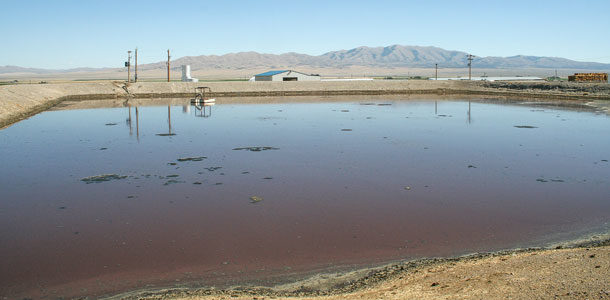When removing manure from a storage pit, it typically must be agitated to minimize solids accumulation and create a uniform fertilizer for field application. However, the act of agitation can destroy certain storage liners if its features aren’t taken into consideration.
Daniel Anderson, agricultural and biosystems engineering extension specialist at Iowa State University, says the goal of manure storage is to create a safe, non-leaking containment structure.
Agitation can be done with an inclined-shaft, propeller-type agitator; a centrifugal chopper agitator; or an agitation boat.
To get a nice uniform mix, research suggests turning over the manure at least three times. That’s not achievable, Anderson says. What is more realistic is a single turnover. For a 10-million-gallon storage with a pump that can mix 6,000 gallons per minute, agitation would have to start 28 hours before manure is removed for land application.
Agitating storage for 24 hours before application starts doesn’t always happen. “The weather we encounter each year will impact whether or not we can do that,” Anderson says.
Most manure haulers will keep the agitator running as they empty the pit but will slow down or stop toward the end, especially when working with an earthen basin.
In addition to earthen storage, Anderson says there are two other types of methods to line manure storage – concrete and geo-synthetic.
Earthen
Earthen basins typically cost less and can usually accommodate some lot runoff, Anderson says. Building this type of storage usually requires a soils investigation and seal construction to make it leak-proof.
Made with compacted clay, this structure is strong and will not rip and tear like geo-synthetic liners.
Clay liners are erodible, especially if using an agitator sitting in one spot. If using a traditional agitator, erosion risk is limited to a single area. An agitation boat that moves around the pit has a risk everywhere in that storage, Anderson says. As long as the boat moves continuously and the jets are set for the right depth, it won’t destroy the earthen liner.
Anderson adds that someone must monitor the boat or have an automatic shut-off so if it gets stuck, it doesn’t keep running in one spot for long. That could destroy the liner in that area.
Concrete
Concrete is a strong material, and there is no concern about the liner tearing or eroding. However, producers should be mindful about cracks in the concrete, as even small cracks can reduce the stability of the structure.
Erosion around the outside of the structure should also be watched, as the walls were designed to have soil support. Maintaining vegetation and diverting storm water runoff are ways to prevent erosion.
In terms of agitation, there are no real concerns about harming concrete-lined manure storage.
Geo-synthetic
While there is no erosion concern with geo-synthetic liners, they are very tear-prone. “If you drive on it, chances are you will rip it,” Anderson says.
A geo-synthetic liner is pretty thick, as thick as a credit card; however, improper installation can result in bubbles, wrinkles and holes that can lead to further damage with agitation.
It starts with subgrade preparation, he says. A nice and smooth surface with no rocks or sharp objects is ideal. If you’re constructing this storage in the same space as a previous storage structure, remove all organic material so it cannot generate methane gas and cause the liner to bubble up.
Once there is a smooth subgrade, lay down a padding layer. This heavy, woven geo-synthetic pad will provide a cushion under the liner. Then place the liner, trying to avoid wrinkles. Any wrinkles 4 to 6 inches or larger are something to worry about, Anderson notes.
“Those wrinkles and holes in the liner might start flapping back and forth as we’re agitating,” he says.
If a flap gets caught in an agitator’s chopping blade, it will rip it to shreds, and the liner will be worthless. Liquid jets from agitators can also cause a geo-synthetic liner to flap and tear.
After the liner is put down during the installation, the seams need to be sealed, either with an extrusion weld, chemical solvent weld or glue, to prevent it from pulling up when blasted with a water cannon. Some companies will put a cover strip over the seam or grind seams so there is nothing left to flap. A good installer will use an air wand to test every seam to make sure it is properly sealed, Anderson says.
Some people will put a soil cover over a geo-synthetic liner. This is about 6 to 12 inches of solids that aren’t supposed to be removed when pumping out. The effectiveness of a soil cover depends on how the pit will be agitated, as it can be very difficult to tell the difference between the soil cover and the manure sludge built up in the bottom of the storage.
Regardless of the type of liner, Anderson says it is helpful to have access ramps or platforms to get agitators in and out of the manure storage. Agitation boats can enter and exit a variety of ways depending on how they are built; some have tires while others do not.
An access ramp made with concrete is the best option, as it is easy to get in and out without worrying about damaging a liner. It can also provide localized protection from scouring the bottom of an earthen basin.
When working with manure storage, safety is always a concern, Anderson says. Be cautious of people falling in, equipment falling in and the release of gases from agitation.
“Even though we’re outside, there is still a risk from hydrogen sulfide emissions,” he says.
Knowing the type of liner and its pitfalls can help make sure agitation goes smoothly, and a safe, non-leaking containment structure is maintained. PD
PHOTO
Regardless of the type of liner, Anderson says it is helpful to have access ramps or platforms to get agitators in and out of the manure storage. Photo byPDstaff.

Karen Lee
Editor
Progressive Dairyman





